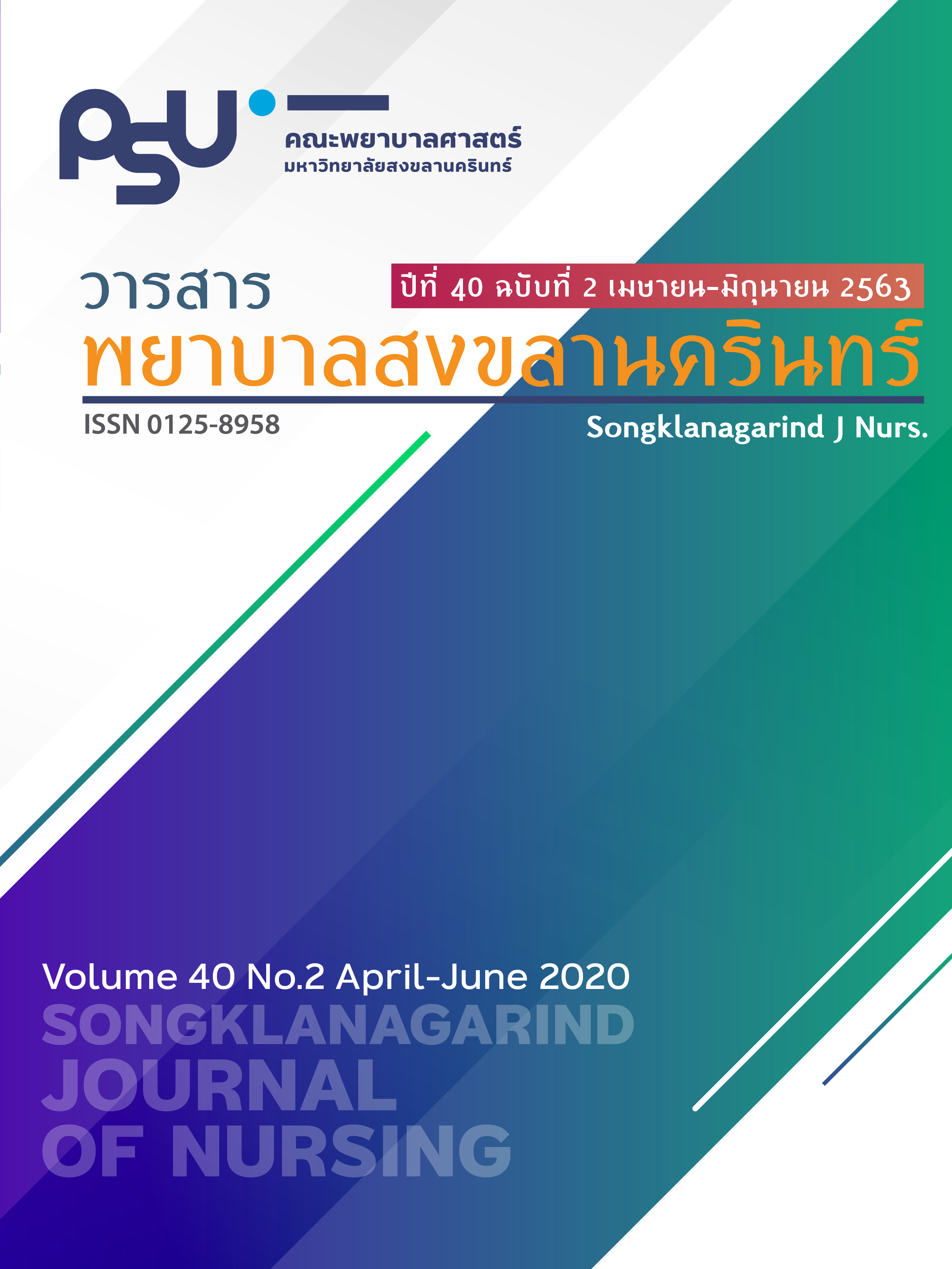Head Nurse’s Advocacy for the Nursing Profession in Thailand
Main Article Content
บทคัดย่อ
The study aimed to determine the level of advocacy for the nursing profession amongst head nurses in Thailand, drawing 541 participants from 26 Thai general hospitals. Subjects were recruited through simple random sampling; and the Thai Head Nurses’ Advocacy for the Nursing Profession Scale (ANPS-Thai) chosen as a research instrument. ANPS-Thai had a content validity index with an I-CVI range of .80 to 1.00, an S-CVI/UA (universal agreement) score of .92, and an S-CVI/Ave (average) score of .98. Data were analyzed using descriptive statistics and independent t-test.
Results revealed the mean scores of advocacy for the nursing profession and subscales. The mean scores of overall advocacy for the nursing profession was 3.92 (SD = .49), and that for the subscales of proactivity to protect professional image 4.34 (SD = .45), while the mean score managing for maximum quality was 4.10 (SD = .49). Cooperating with others and sacrifice had a mean of 3.91 (SD = .64) while the mean of speaking out to enhance professional worth was 3.79 (SD = .62). The results indicated statistically significant mean advocacy score differences between nurses holding master’s and/or doctoral degrees and those holding bachelor degrees (t = 3.57, p < .01). There was no significant difference in the mean score of overall ANPS-Thai between five years or more experience and those with less than five years.
The study’s findings will provide nursing organizations in Thailand with baseline data that enables them to establish strategies to further foster nursing profession advocacy.
Article Details
เอกสารอ้างอิง
Davoodvand S, Abbaszadeh A, Ahmadi F. Patient advocacy from the clinical nurses’ viewpoint: a quality study. J Med Ethics Hist Med. 2016; 9(5).
Tomajan K. Advocating for nurses and nursing. Online J Issues Nurs. 2012; 17(1): 4. doi: 10.3912/ OJIN.Vol17NO01Man04.
Dadzie G, Aziato L, Aikins A. We are the best to stand in for patients: a quality study on nurses’ advocacy characteristics in Ghana. BMC Nursing. 2017; 16(61). doi: 10.1186/ s12912-017-0259-6
Jennifer H. Matthews. Role of professional organizations in advocating for the nursing profession. Online J Issues Nurs. 2012; 17(1). doi: 10.3912/OJIN.Vol17No01Man03
Needleman J. Hassmiller S. The role of nurses in improving hospital quality and efficiency: real world result. Health Aff. 2009; 28(4): 625-33. doi: 10.1377/hlthaff.28.4.w625
Thailand and Nursing Midwifery Council. Competencies of registered nurses; 2010. Available from http://www.tnc.or.th/files/2010/ 02/page38/professional_competency_pdf_ 10152_28999.pdf
The Nurses’ Association of Thailand. Code of ethics for nurses; 2003. Bangkok. Available from http://www.nur.psu.ac.th/Report_mis/file/ b.pdf (Thai version)
Altuntas S, Baykal U. Relationship between nurses’ organizational trust levels and their organizational citizenship behaviors. Journal of Nursing Scholarship. 2010; 42(2): 186-94. doi: 10.1111/j.1547-5069.2010.01347.x
Ozdermir, Guven N. The Development of nurses’ individualized care perceptions and practice: Benner’s novice to expert model perspective. IJCS. 2019; 12(2): 1279-85.
Hanks RG. Development and testing of an instrument to measure protective nursing advocacy. Nursing Ethics. 2010; 17(2): 255-67. https://doi.org/10.1177/0969733009352070
Matthews J. Role of professional organizations in advocating for the nursing profession. OJIN. 2012; 17(1). doi:10.3912/OJIN.Vol17 No01man03.
McHugh M, Lake TE. Understanding clinical expertise: nurse education, experience, and the hospital context. Res Nurs Health. 2010; 33(4):276-87. doi: 10.1002/nur.20388.
Maryland M, Gonzalez R. Patient advocacy in the community and legislative arena. Online J Issues Nurs. 2012; 17(1): 1. doi: 10.3912/OJIN. Vol17No01Man02.
Lucatorto AM, Thomas WT, Seik T. Registered nurses as caregivers: influencing the systemas patient advocates. Online J Issues Nurs. 2016; 21(3): 2. doi: 10.3912/OJIN.Vol21No03 Man02.
Shohani M, Sahebi A. The level of professional autonomy in Iranian nurses. Journal of Clinical and Diagnostic Research. 2018; 12(5): LC01-LC04. doi: 10.7860/JCDR/2018/31249. 11465
Hoskins K, Grady C, Ulrich C. Ethics education in nursing: instruction for future generations of nurses. Online J Issues Nurs. 2018; 23(1): p 4-4. doi: 10.3912/OJIN.Vol23No01Man03.
Pengmak T, Chaowalit A, Nasea T. Development and psychometric evaluation of Thai head nurses’ advocacy for the nursing profession scale (ANPS-Thai). [Dissertation]. [Songkhla]: Prince of Songkla University; 2018. 161 p.
Polit DF, Beck CT. Nursing research: generating and assessing evidence for nursing practice. 9 th ed. Philadelphia: PA: Wolters Kluwer; 2018.
Aly NAE-FM, Ghoneim TAM, Hassan OS. Role of head Nurses in managing the safety of high alert medications in critical care units. Journal of Natural Sciences Research. 2016; 6(8): 80-9.
Jainpong S. Factors related to participation of professional nurses in hospital quality improvement in community hospitals, prachinburi province. EAU Heritage Journal. 2012; 6(1): 121-32.
Marquis BL, Huston CJ. Leadership roles and management function in nursing: Theory and applications. 7 th ed. Philadelphia: PA: Lippincott Williams & Wilkins; 2012.
Masters K. Evidence-Based Professional Nursing Practice. In: K Masters, editor. Role Development in Professional Nursing Practice. 4 th ed. Burlington MA: Jones & Bartlett Learning; 2017.
Black BP. Professional nursing: Concept & challenges. 8 th ed. St. Louis: MO Elsevier; 2017.
Pongthong W, Wisesrith W. A study of professional nurses autonomy in hospitals and medical centers, Ministry of public health. Kuakarun Journal of Nursing. 2017; 24(1): 86- 101.
Koch RW. Contemporary nursing roles and career opportunities. In Cherry B, Jacob SR, editor. Contemporary nursing: Issues, trends, & management. 7th ed. St. Louis, MO: Elsevier; 2017.
Ozturk H. Development of an administrative ethical behavior scale. Nursing Ethics. 2012; 19(2): 289-303. doi: https://doi.org/10.1177/ 0969733011419240


